oladulce
Super Nomad
   
Posts: 1625
Registered: 5-30-2005
Location: bcs
Member Is Offline
|
|
Shark Tooth Cuidadero
I have a question about shark's teeth and was looking through my photos for an example of the shell/rock mix that we usually find them in.
I knew we had photo of a trantula that was on our patio this summer, and thought it had a good close-up of the shells, but I hadn't noticed what was
between his front feet until today.
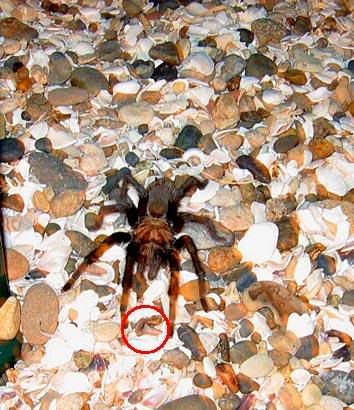

|
|
|
Sharksbaja
Elite Nomad
     
Posts: 5814
Registered: 9-7-2004
Location: Newport, Mulege B.C.S.
Member Is Offline
|
|
Looks like Isurus hastalis...Extinct Mako

[Edited on 1-5-2006 by Sharksbaja]
|
|
|
oladulce
Super Nomad
   
Posts: 1625
Registered: 5-30-2005
Location: bcs
Member Is Offline
|
|
Sharksbaja-
While searching the Nomad archives I came across the photo of your tooth collection. Very cool, and the labels on your collection were a helpful
reference.
During the El Ni?o years '92-'93, the increase in rain and wave activity washed away beach and arroyo sand and exposed layers of rocks and shell that
are normally covered by several feet of sand. During that brief era, there were a couple of magic places where we could sit on the beach in a pile of
shell/rocks (like in the trantula photo) and sift our hands through a few times and come up with shark tooth pieces. Sometimes we were lazy and would
drive slowly through the shells and I'd lean out of the dune buggy and yell "stop" when I saw a tooth.
We found mostly large megladon tooth fragments, some pieces nearly as long as the width of my palm. I never found a huge intact one like some of my
neighbors have, but it was exciting just the same.
The sand gradually returned and is now as much as 10 feet deep over the area and you'd never know those treasures were down there. The exposure of the
tooth beds may have been a once-in-a-lifetime event, and we feel lucky to have been there.
I've always wondered, if Megladon and the other big extinct sharks were around 10 millon years ago, but the peninsula split from the mainland only 4-5
millon years ago, were these sharks teeth deposited while it was a mainland beach and they traveled over with the land mass? It's hard to imagine this
or other cataclysmic events, because often we'd find the teeth perfectly positioned on top of a pile of shells like they were on display.
|
|
|
Taco de Baja
Super Nomad
   
Posts: 1913
Registered: 4-14-2004
Location: Behind the Orange Curtain, CA
Member Is Offline
Mood: Dreamin' of Baja
|
|
There is a TON of info on fossil sharks at Elasmo
It takes a while to get used to the site but, has many pictures and info on the evolution and lineage of sharks. It?s easy to get lost with all the
different links presented on each page, some at the top, some on the side, some on the page...and all of it interesting, at least to a paleontologist

Here's some info on the extinct Great White Carcharocles
Where exactly (or approximately  ) did you collect the teeth. ) did you collect the teeth.
I agree with sharksbaja that the tooth in the picture looks like an Isurus, unless it has serrations (can't tell from the pic), then it is
probably one of those transitional species between great whites and mackos (Cosmopolitodus ) or just a regular great white (Carcharodon
carcharias )
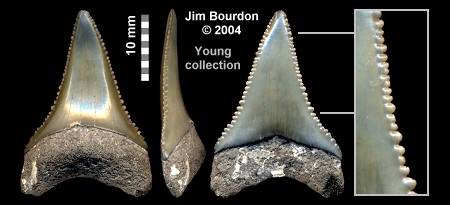
Carcharodon carcharias
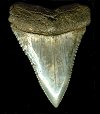
Cosmopolitodus
|
|
|
Sharksbaja
Elite Nomad
     
Posts: 5814
Registered: 9-7-2004
Location: Newport, Mulege B.C.S.
Member Is Offline
|
|
Taco time-out
| Quote: | Originally posted by Taco de Baja
It takes a while to get used to the site but, has many pictures and info on the evolution and lineage of sharks. It?s easy to get lost with all the
different links presented on each page, some at the top, some on the side, some on the page...and all of it interesting, at least to a paleontologist

Where exactly (or approximately  ) did you collect the teeth. ) did you collect the teeth.
I agree with sharksbaja that the tooth in the picture looks like an Isurus, unless it has serrations (can't tell from the pic), then it is
probably one of those transitional species between great whites and mackos (Cosmopolitodus ) or just a regular great white (Carcharodon
carcharias )

----------------------
YOU SAY 'CARCHARODON', I SAY 'CARCHAROCLES'
Actually, you may be right but you may be wrong also Taco on which order the Makos and GR whites and Megalodon fall into.
This debate has raged on for a long time. My personal opinion after studying the teeth up close convincees me that Megalodon and GR whites share the
same order or DNA profile simply because of the V-shape and serrations. Mako teeth have none .
-------------------------
Great White.org:
"Upon researching further and digging into the depths of material on Megalodon at my local university library, I came upon a controversy that
apparently has been raging between paleontologists (scientists who study fossils to learn about animals of the past) and marine biologists for a few
years. It seems that several prominent paleontologists believe that Megalodon should really be classified as Carcharocles megalodon and not
Carcharodon megalodon.
Big deal, right? Who cares what we call a long-dead shark? Plenty of folks, it turns out. As Jim Bourdon points out at his excellent website,
Megalodon is a "poster child" for those who study sharks much like Tyrannosaurus rex is for those who study dinosaurs. Imagine the uproar if
paleontologists came forward and wanted to change its name from T. rex to T.somethingelseus and you start to understand the emotional nature of the
controversy.
As for the factual basis of controversy, this can be found in studying the ancestry of the GW. GWs are part of a grouping known as mackerel sharks, a
grouping which includes the salmon, porbeagle, and mako sharks. One of the mako's ancestors is an extinct shark known as Isurus hastalis. Comparisons
of the teeth of I. hastalis and C. carcharias reveals that they are remarkably similar, the only difference being that I. hastalis teeth are smooth,
lacking serrations. In the mid-80s, a 5-million year old shark specimen was found that some scientists have concluded links I. hastalis with C.
carcharias as it had "weakly" serrated teeth. If true, this could indicate that the GW is a likely descendent of I. hastalis.
These teeth from the modern GW (left) are quite similar to the teeth of the extinct I. hastalis (right) but notice the lack of serrations in I.
hastalis.
Here's where it gets fun. Let's say that the GW is a descendent of this ancient mako-like shark. Megalodon does not share this immediate ancestry and
thus, belongs in a different genus entirely. Carcharocles had been put forth as a genus for a few other species (C. angustidens, C. auriculatus, &
C. sulcidens for those keeping score at home) and it is in this genus that some say Megalodon belongs.
In support of the Carcharodon camp are three main points as given by Dr. Samuel Gruber - again, by way of Jim Bourdon's website.
There is a unifying tooth structure that connects all the great tooth sharks to the living C. carcharias i.e. tooth shape & the arrangement and
placement of these teeth in the jaw
Fossil teeth assigned to C. carcharias have been found in deposits that are much older than the teeth from the 5-million year old specimen I referred
to above that supposedly links Isurus hastalis and C. carcharias meaning that the GW has been swimming around since before this "intermediate" species
appeared.
Biochemical (DNA) evidence presented by Andy Martin strongly suggests that Isurus hastalis and Carcharodon diverged 40 my ago well before the age of
the "intermediate tooth."
What does it all mean? It depends on your viewpoint - how badly do you want C. megalodon to be related to C. carcharias? Judging from the heated
exchanges I've read on the Internet, plenty of experts are on either side of the debate with most paleontologists firmly on the side of Carcharocles
and most marine biologists showing their love for Carcharodon.
THE HUMBLE OPINION OF AN IDIOT
Me? I have to say that the Carcharocles camp seems to hold the most weight in my mind. I've got tooth specimens from Otodus obliqus, C. auriculatus,
I. hastalis, and I. escheri in my collection and I can see the progression that Bill Heim and others have argued - but hey, who am I?? Just a guy from
Arizona. I will say that the compelling piece of evidence for me is the tooth shape from these two progressions - the teeth that lead to C. carcharias
all share a certain degree of "flatness" while the teeth that lead to C. megalodon have a more cone-like shape."
So, the jury is still out. I would like to know if anyone has found a tooth from an extinct great white.
Ola candy:
You obviously hit the Mother Lode. My thinking is that 10-15 million years ago the peninsula while still part of "Pangea",North and South America
split off . The depth of the SOC and the recent earthquake may attest to that. Also many volcanic flows occured. Events like that bring millions of
years of deposits toward the surface. It's lucky to discover an ancient seabed where lagoons and shallows constantly left animals remains. It is a
fantastic sight with thousands of teeth and sometimes other petrified animals like the awesome ammonites can be found.
Shark teeth like the one you show is a typical example that can be found in many parts of the world. Many times these teeth are found in sandstone
and it renders the toothy fairly brittle. Many megalodon teeth on the other hand from rich mineral laden SE USA yield very hard teeth.
I. Hastalis can be found in abundance in Chile and Peru. Were the m. carcharocles pieces of poor quality. The ones I have seen were pretty worn and
unattractive with little esthetic value.
In which areas have you seen them? Were your neighbors with you?
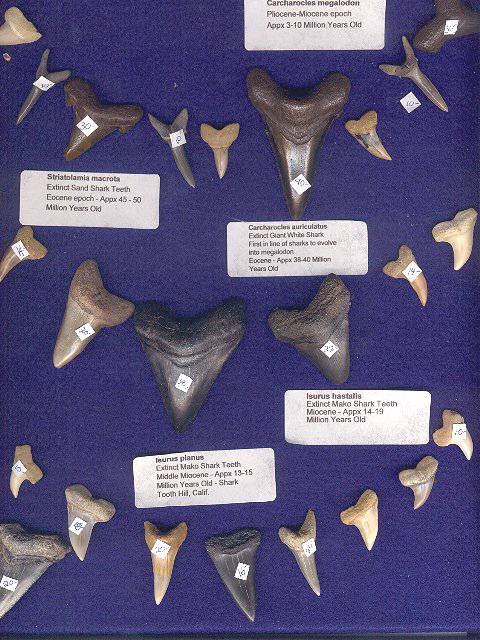
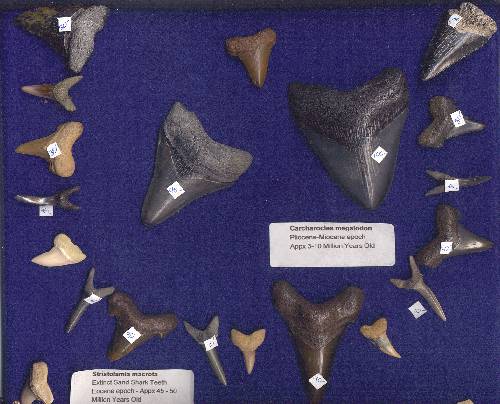
notice the bicuspid type tooth of the extinct great white:
[Edited on 1-22-2006 by Sharksbaja] |
|
|
|
Taco de Baja
Super Nomad
   
Posts: 1913
Registered: 4-14-2004
Location: Behind the Orange Curtain, CA
Member Is Offline
Mood: Dreamin' of Baja
|
|
| Quote: | Originally posted by Sharksbaja
YOU SAY 'CARCHARODON', I SAY 'CARCHAROCLES'
Actually, you may be right but you may be wrong also Taco on which order the Makos and GR whites and Megalodon fall into.
This debate has raged on for a long time. ..... |
I thought the current accepted nominclature for the genus Carcharodon was for the great white, and the genus Carcharocles was
limited to the extinct great white .... specifically Carcharocles megalodon (the big boy with the 6+ inch teeth)
But I agree that paleontologists can be as bad as botanists when it comes to naming things?next year it may be Carcoocoodon 
Oh well, the teeth are still cool no matter what they are called.
|
|
|
Sharksbaja
Elite Nomad
     
Posts: 5814
Registered: 9-7-2004
Location: Newport, Mulege B.C.S.
Member Is Offline
|
|
Who REALLY knows?
For sure! I don't spend as much time as I used to on such trivial matters. I'd much rather just wear one (whatever they are called) round' me neck!
My choice would be charcoalessenceaplease 
|
|
|
Cincodemayo
Senior Nomad
  
Posts: 725
Registered: 3-7-2005
Location: Pacific NW
Member Is Offline
|
|
Sharks...
Great collection. This guy has incredible serious collector specimens but his site is a beautiful place for info and great photos. He's definitely
serious about his passion also as you will see with the pricing and rarity.
http://www.megalodonsharkteeth.com/index.htm
Don\'t get mad...
Get EVEN.
|
|
|
oladulce
Super Nomad
   
Posts: 1625
Registered: 5-30-2005
Location: bcs
Member Is Offline
|
|
Piece of a big guy.
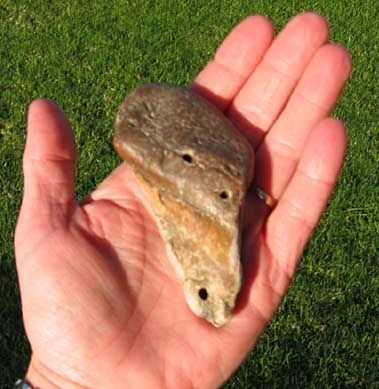
[Edited on 1-7-2006 by oladulce]
|
|
|
Sharksbaja
Elite Nomad
     
Posts: 5814
Registered: 9-7-2004
Location: Newport, Mulege B.C.S.
Member Is Offline
|
|
That's old!
Do you have an idea how old. It's been in the surf awhile. You can get an approximation by looking at the others nearby of different species then
figure which date supported both/all regionally.
One of my 5 inchers:
|
|
|
Taco de Baja
Super Nomad
   
Posts: 1913
Registered: 4-14-2004
Location: Behind the Orange Curtain, CA
Member Is Offline
Mood: Dreamin' of Baja
|
|
Also looks like it has been drilled into by Pholad clams, Suggesting it sat on the bottom for a while.
My belief is it is a reworked tooth from an older formation that eroded out and was redeposited onto a younger marine terrace deposit.
Thanks for sharing the photo 
If you have any other species, post some pics of them too.
|
|
|
oladulce
Super Nomad
   
Posts: 1625
Registered: 5-30-2005
Location: bcs
Member Is Offline
|
|
Taco-
I don't have a lot of intact teeth, mostly pieces of the big ones.
These are a few of my intact ones. In this Modern Era, they can be found in a Ba?o Domesticus layer.
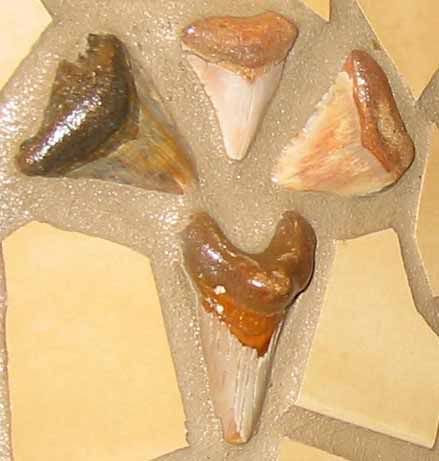
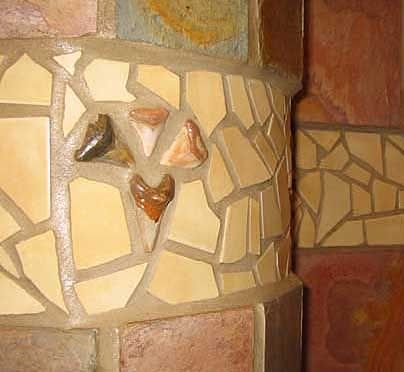
|
|
|
Sharksbaja
Elite Nomad
     
Posts: 5814
Registered: 9-7-2004
Location: Newport, Mulege B.C.S.
Member Is Offline
|
|
Cool! Are those from Baja?
|
|
|
oladulce
Super Nomad
   
Posts: 1625
Registered: 5-30-2005
Location: bcs
Member Is Offline
|
|
S? se?or.
|
|
|
Taco de Baja
Super Nomad
   
Posts: 1913
Registered: 4-14-2004
Location: Behind the Orange Curtain, CA
Member Is Offline
Mood: Dreamin' of Baja
|
|
Cooool!
All look like Megalodons. What's the length? 3-4"?
|
|
|
oladulce
Super Nomad
   
Posts: 1625
Registered: 5-30-2005
Location: bcs
Member Is Offline
|
|
Naw, the shower photo is misleading and the largest one there is 2.5". The piece in my hand is 4.25".
I hesitated to post my shower photo fearing "environmental correctness" but what the heck, it seems a shame to keep them in a jar on a shelf. I wish I
would have saved them for our Baja shower though because these were my best ones.
If I ever found a truly unique, huge and intact shark tooth (or arrowhead ) I'd probably take a photo and then return it or bury it onsite. Not sure
if that's a "karma" or "cosmic-energy" thing, but it would feel like the right thing to do.
[Edited on 1-8-2006 by oladulce]
|
|
|
Taco de Baja
Super Nomad
   
Posts: 1913
Registered: 4-14-2004
Location: Behind the Orange Curtain, CA
Member Is Offline
Mood: Dreamin' of Baja
|
|
Take a trip to the shark exhibit at Sea World in San Diego. They have a bunch of Megs cemented into the walls. And although they do keep sea life in
"cages" Sea World is pretty "environmentally correct". Nothing wrong with displaying your treasures.
|
|
|
Tomas Tierra
Super Nomad
   
Posts: 1281
Registered: 3-23-2005
Location: oxnard, ca
Member Is Offline
Mood: Tengo Flojera
|
|
Ola Dulce,
I was told by more than one old timer (mexican variety) in S.J. that it was good luck/karma to give the sharks teeth away..Not sure why?
Wild that it is all covered up now! The ones I did not give away I have displayed in a glass case..
Hillarious! My wife and I did the out the window thing to! Spilled alot of beer 
THey are some of my favorite treasures.. If I can figure out the photo thing, I will post my case..Don't hold your breath!
TT
|
|
|
oladulce
Super Nomad
   
Posts: 1625
Registered: 5-30-2005
Location: bcs
Member Is Offline
|
|
Tomas
I'm anxious to see your tooth collection.
I like to use Photobucket as an image hosting site because it's easy to use, free, and photos don't expire like some sites.
After you sign up and "submit" a photo to your album, they give you 3 options of addresses to link to your photos.
Click on "Img" which is the address to use for putting your photos on BBs. "Copy" the Img address, then "paste" it directly in to your Nomad post.
http://photobucket.com/
|
|
|
Frank
Senior Nomad
  
Posts: 861
Registered: 6-5-2005
Location: San Diego
Member Is Offline
Mood: Is it time to leave yet?
|
|
| Quote: | Originally posted by Tomas Tierra
Ola Dulce,
I was told by more than one old timer (mexican variety) in S.J. that it was good luck/karma to give the sharks teeth away..Not sure why?
TT |
If you need to give away shark teeth, Im here for you guys! I want you to have good luck and good Karma. 
|
|
|

